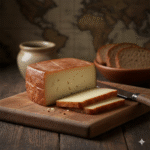Cheesemaking is an art built on technique, time, and the right tools. Among these essential tools, the rectangular cheese form stands out for its practicality, versatility, and ability to deliver uniform results. Whether you are a home cheesemaker or running a small dairy operation, understanding how this mold works can elevate both the texture and appearance of your cheese.
In this guide, we explore everything you need to know—what rectangular cheese forms are used for, the materials they come in, how to maintain them, and tips for choosing the best one for your needs.
What Is a Rectangular Cheese Form?
A rectangular cheese form, often called a rectangular cheese mold, is a rigid and perforated container used during the shaping and pressing stage of cheesemaking. The mold defines the final shape of the cheese block while letting whey escape evenly through tiny holes.
Its straight edges and uniform angles make it ideal for cheeses cut into slices, cubes, or blocks—perfect for aging, packaging, or direct consumption.
Common cheeses that use rectangular forms include:
-
Paneer
-
Feta
-
Halloumi
-
Queso fresco
-
Pressed farmstead cheeses
-
Semi-hard varieties for aging
Whether you want a compact cheese for cooking or a firm block for slicing, this mold creates clean, consistent results.
Uses of a Rectangular Cheese Form
Rectangular cheese forms offer several functional advantages:
1. Shaping Pressed Cheeses
When curds are ready to be pressed, the mold shapes them into a tight, stable block. This helps produce a uniform texture throughout the cheese.
2. Promoting Even Whey Drainage
The perforations allow whey to escape evenly from all sides, ensuring smoother and firmer cheese without trapped moisture.
3. Improving Aging Consistency
Cheesemakers often use rectangular molds for aging cheeses that benefit from flat surfaces and compact shapes. The uniform shape allows for predictable rind development.
4. Facilitating Cutting and Packaging
Block-shaped cheeses are far easier to portion, wrap, and store. This makes rectangular forms popular among dairies and artisan producers.
5. Creating Stackable Cheese Blocks
The geometry makes stacking for aging or storage simple, saving space in coolers or aging rooms.
Common Materials Used in Rectangular Cheese Forms
Rectangular cheese molds come in various materials, each with pros and cons:
1. Food-Grade Plastic (Most Common)
-
Lightweight
-
Affordable
-
Easy to clean
-
Resistant to acidic whey
-
Ideal for beginners and home cheesemakers
2. Stainless Steel
-
Extremely durable
-
Excellent for commercial use
-
Holds shape under heavy pressure
-
Resistant to odors and stains
However, stainless steel molds are more expensive.
3. Traditional Wood
Less common today, wooden molds are used for historically crafted cheeses.
-
Adds unique flavor
-
Requires more care
-
Not ideal for beginners
4. HDPE (High-Density Polyethylene)
A professional-grade plastic known for strength and food safety.
How to Care for a Rectangular Cheese Form
Proper care ensures long life and safe cheese production:
1. Clean Immediately After Use
Whey and curd residue can dry quickly. Rinse the mold with warm water and a mild, non-fragranced detergent.
2. Avoid Abrasive Scrubbers
Scratching the perforations can create bacteria-harboring grooves. Use a soft brush for cleaning holes.
3. Sanitize Before Each Batch
A quick soak in hot water or a food-safe sanitizing solution keeps the mold sterile.
4. Dry Completely
Store molds in a dry area to prevent mold growth (the fungal kind—not the cheesemaking kind!).
5. Inspect Holes Regularly
Blockages in the perforations affect drainage and cheese texture. Clear them with a soft brush or toothpick if necessary.
Buying Guide: How to Choose the Right Rectangular Cheese Form
When shopping for a rectangular cheese form, consider the following:
1. Size & Capacity
Choose based on the typical batch size you make—small molds work for home use, while larger ones are ideal for dairies.
2. Material Quality
-
For regular use → food-grade plastic
-
For professional or heavy pressing → stainless steel
3. Number & Size of Perforations
More perforations = better whey drainage, especially for soft and fresh cheeses.
4. Press Compatibility
Ensure it fits your cheese press if you use one.
5. Durability
Look for thick walls and sturdy construction to withstand pressure.
6. Price & Brand
Reputable cheesemaking suppliers often offer high-quality molds with better longevity.
Why Rectangular Cheese Forms Are Popular
Rectangular molds are preferred because they offer:
-
Clean and professional cheese appearance
-
Easy cutting and portioning
-
Consistent results with every batch
-
Efficient whey removal
-
Versatility across many cheese types
They are one of the most practical tools for anyone serious about making cheese at home or commercially.
Final Thoughts
A rectangular cheese form is far more than just a piece of equipment—it’s a crucial tool that determines how your cheese looks, drains, and ages. Whether you’re crafting feta, paneer, or a semi-hard block, using the right mold ensures better texture, shape, and flavor development.
Investing in a high-quality rectangular cheese form will not only improve your cheesemaking results but also streamline the entire process.



